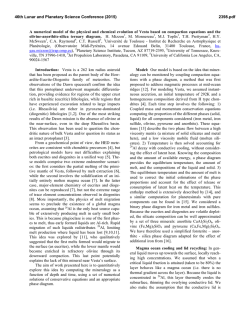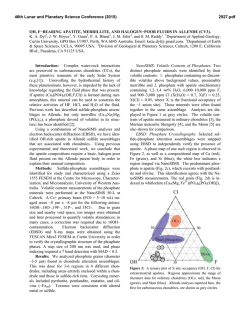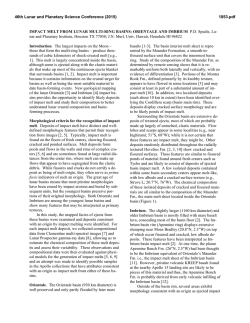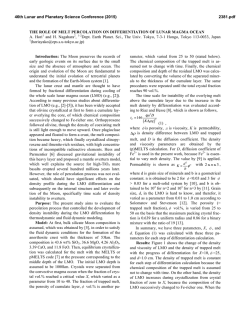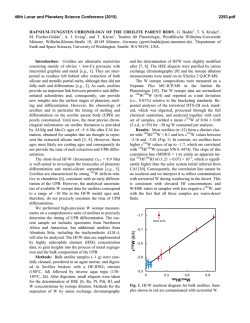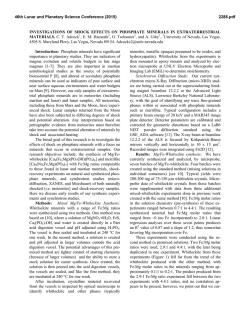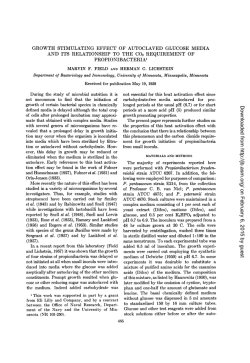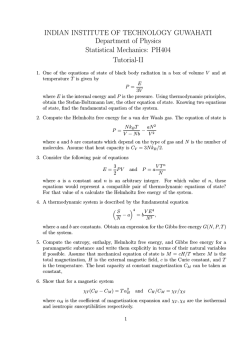
1998
46th Lunar and Planetary Science Conference (2015) 1998.pdf AN ASSESSMENT OF CURRENT PREDICTIVE MODELS FOR PHOSPHATE SATURATION IN SILICATE LIQUIDS. A. R. Santos1, F. M. McCubbin1, A. S. Bell1, E. S. Whitson1, 1Institute of Meteoritics, 1 University of New Mexico, MSC03-2050, Albuquerque, NM 87131 ([email protected]). Introduction: Phosphate minerals such as apatite and merrillite are ubiquitous among inner Solar System samples available for study, and are often petrologically important hosts for rare earth elements and volatiles. Apatite is one of the most abundant volatile-bearing minerals found in igneous systems on other planetary bodies, and much attention in recent years has been focused on using apatite to constrain planetary volatile budgets [e.g., 1-4; although caution is required in this process, 5]. A critical factor in using phosphate minerals to determine melt volatile contents at the time of crystallization is the degree of melt crystallization required to reach phosphate saturation; this is required to calculate volatile contents and understand what stage along the liquid line of descent is represented by apatite crystallization. The ability to determine degree of crystallization relies on knowledge of apatite saturation in silicate liquids, which has been examined in a number of studies [6-10]. Application of mineral solubilities to numerous planetary bodies often requires extrapolation of derived models and experimental results, as composition, temperature, fO2, and pressure of igneous processes vary across the Solar System. These extrapolations require models to be robust and fully capture the effects of changing parameters on solubility, and we have examined the ability of three such models to predict phosphate saturation at conditions largely beyond those at which they were calibrated. We examined these models using a wealth of phase equilibrium experiments that were originally aimed at understanding the partitioning behavior of F, Cl, and H2O between apatite and silicate melts of martian composition. We have focused on the models of [6] (referred to as H&W), [9] (Tol), and [11, 12] (the MELTS program). The H&W and Tol models are empirical models that are functions of melt SiO2 content and temperature, and melt SiO2 and CaO contents and temperature, respectively. The MELTS algorithm predicts phosphate saturation using regressions through thermodynamic data determined from a large experimental database. These three models were derived over specific conditions of P, T, and X, and were derived using mostly terrestrial melt compositions in their calibration datasets. Methods: We utilize the apatite saturation experiments of [13, 14] to test the listed saturation models, along with 2 new sets of experiments designed to saturate in the phosphate merrillite. One set of new experiments were conducted using a volatile free starting material of [13, 14] that was seeded with crystals of Yukon whitlockite to induce phosphate saturation. These experiments were conducted at 1 GPa in a piston cylinder apparatus at 1100°, 1200°, and 1300° C. Another set of new experiments was conducted using a starting composition after QUE 94201 doped with ~8 wt% P2O5 to force phosphate saturation at the liquidus. These experiments were run at 1 bar with CO-CO2 controlled fO2 in a vertical Deltech furnace. Experiments were run at 1100°C at ∆IW+3 and ∆IW+0.5. The studies of [6] and [9] provided equations to define their phosphate saturation models, however it is not clear what portion of the MELTS algorithm is calculating phosphate saturation. In order to assess MELTS in the same way as the other models, we derived an empirical equation (referred to as MA) that describes the phosphate saturation predictions of the actual algorithm over the conditions of interest by querying the MELTS database. This was done using 79 melt compositions with different initial SiO2 and P2O5 contents, which were entered into the MELTS program to determine the temperature, SiO2, and P2O5 contents of the liquid at the time of phosphate saturation. This procedure showed that within the MELTS algorithm, the melt SiO2 content has an insignificant effect compared to that of temperature in determining melt P2O5 content at phosphate saturation. The three models were used to predict melt phosphate content at phosphate saturation and isothermal saturation curves at temperatures relevant to the experiments as a function of melt SiO2 content. We used SiO2 contents between 30-55 wt%, and maintained a constant SiO2/CaO ratio (derived from the experimental starting composition) when determining CaO content for use in the Tol model (isothermal saturation fields were derived for this model as a result of its consideration of melt CaO along with SiO2). Results: Figure 1A shows the calculated melt P2O5 at saturation plotted against the measured melt P2O5 at saturation for experiments at 1 GPa. Figures 1B-D show the results of the calculated saturation curves along with experiments at different temperatures. Overall, the models failed to reproduce the experimental dataset in terms of predicting phosphate saturation, even for experiments that fell within the calibrated range of the models. Experiments run at 4 GPa are not shown here, but show similar to greater degrees of disagreement between measured and calculated melt P2O5 contents. The H&W and MA models under predict the experimental melt P2O5 content at saturation, while the Tol model over predicts this value. 46th Lunar and Planetary Science Conference (2015) Comparison of experimental results to isothermal prediction curves indicates the H&W and Tol models match the overall trend in P2O5 content with SiO2 between 950-1050°C, indicating these predictions are matching the real behavior of the saturation curves. The predicted P2O5 values, however, do not agree with the experiments. None of the models work well at SiO2 below 40 wt%. The predictions from MA shows the worst agreement with the experimental data (and also no agreement with the other models). While the models tested work for the compositions and conditions they were established for, they cannot be reliably used at the extrapolated conditions of the experiments. This suggests there are compositional or other parameter effects that are not fully accounted for in the models. One major compositional parameter is the overall melt composition. The H&W model was derived using mostly felsic compositions, but the experimental melt is a basalt. Comparison of the phosphate saturation data from [7 mafic melts], with the model curves shows the same result of actual melt P2O5 contents being higher than the predicted values. The overall agreement in trends shown by the experiments and predicted curves for this model suggest the effect of temperature is less well constrained than the effect of SiO2 in the model equation. The two 1 bar experiments have known fO2 values, and this change in fO2 (IW+0.5 and IW+3) resulted in a greater than 1 wt% difference in melt P2O5 at phosphate saturation. None of the tested models replicated this result, with the largest predicted difference being ~0.2 wt%. Conclusions: Based on these tests of current phosphate saturation models, we conclude that our understanding of phosphate saturation in silicate melts is incomplete. The three models tested here may work for the specific compositions, temperatures, and pressures they were derived for, but their use outside these conditions is unlikely to be effective. We are working toward experimentally deriving saturation models for the three endmember apatites (F, Cl, OH), and separate saturation models for merrillite that cover a wide range of temperature, pressure, oxygen fugacity, and melt composition relevant to planetary igneous systems. References: [1] McCubbin F. M. et al. (2010) PNAS, 27, 11223-11228. [2] Boyce J. W. et al. (2010) Nature, 466, 466-469. [3] Gross J. et al. (2013) EPSL, 369, 120-128. [4] Sarafian A. R. et al. (2013) MAPS, 48, 2135-2154. [5] Boyce J. W. et al. (2014) Science, 344, 400-402. [6] Harrison T. M. and Watson E. B. (1984) GCA, 48, 1467-1477. [7] Watson E. B. (1979) GRL, 6, 937-940. [8] Sha L. K. (2000) GCA, 64, 3217-3236. [9] Tollari N. et al. (2006) GCA, 70, 15181536. [10] Patiño Douce A. E et al. (2011) Chem. Geol. 288, 14-31. [11] Ghiorso M. S. and Sack R. O. (1995) Contrib. Mineral. Petrol., 119, 197-212. [12] Asimow P. D. and 1998.pdf Ghiorso M. S. (1998) Am. Min., 83, 1127-1131. [13] McCubbin F. M et al. in press Am. Min. [14] McCubbin F. M. et al. (2013) LPSC XLIV, Abstract #2748. Figure 1: A: Plot of predicted melt P2O5 content from the three models tested in this study versus the measured melt P2O5 content from experiments at 1 GPa. B: Isothermal saturation curves from H&W. C: Isothermal saturation fields from Tol. D: Isothermal saturation curves from MA. Colors of symbols indicate the saturating phosphate phase.
© Copyright 2025
